
Reel Times Newsletter
August 2021
Issue 44
When Silvers Shine – Fishing for coho salmon in August
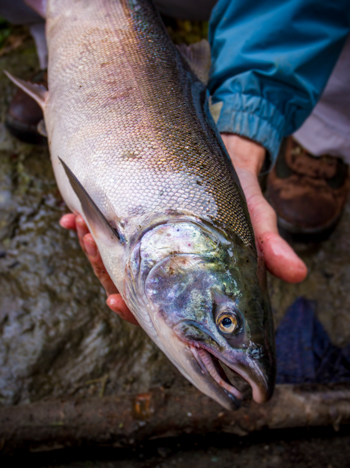 The month of August is one of my favorite times of the year to get out and fish. There are still many opportunities across the state to target salmon species such as sockeye, pink and chum. Perhaps, though, it is the coho or silver salmon that shines brightest this month.
The month of August is one of my favorite times of the year to get out and fish. There are still many opportunities across the state to target salmon species such as sockeye, pink and chum. Perhaps, though, it is the coho or silver salmon that shines brightest this month.
Coho salmon are aggressive fish that can be pursued on fly or traditional hardware. They are strong, energetic fish that are fun to battle on rod and reel and they make great table fare.
In this edition of Reel Times, we share resources to help you target coho salmon. Additionally, we are happy to share a great story about a young angler from Kodiak who went back to the basics one day while out fishing for rockfish.
If you haven’t done so already, You can purchase licenses and stamps in our online store.
Are you following us on social media? If not, be sure to check us out on Instagram @wefishak. You can also follow us on Facebook at ADF&G - wefishak.
If you have a comment or story ideas for Reel Times, we encourage you to send them our way. You can send comments to ryan.ragan@alaska.gov.
We’ll see you on the water.
Division of Sport Fish - Alaska Department of Fish and Game
Southcentral Regional Report
By Tyler Polum and Mark Witteveen
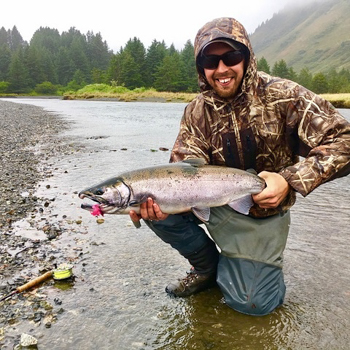 Coho salmon in Alaska offer one of the most diverse fishing opportunities for a single species that are available. Depending on the time of year, location, and conditions, you will need a variety of skills and techniques to target them and produce consistent catches from casting spinners under tree branches, to swinging articulated leech flies across a mirror-still pond, to open water trolling following schools of bait around. Timing is everything, however, and if you pick your spot, tackle, and time right, they are often easy and predictable to catch.
Coho salmon in Alaska offer one of the most diverse fishing opportunities for a single species that are available. Depending on the time of year, location, and conditions, you will need a variety of skills and techniques to target them and produce consistent catches from casting spinners under tree branches, to swinging articulated leech flies across a mirror-still pond, to open water trolling following schools of bait around. Timing is everything, however, and if you pick your spot, tackle, and time right, they are often easy and predictable to catch.
Coho salmon are plentiful in the saltwater a couple weeks before they enter their spawning streams, usually within one or two miles of shore. Coho are prone to jumping more so than other salmon, so keeping a keen eye for jumpers will dial you into schools. Sometimes, if you’re lucky, you can work them into a frenzy at the surface and they’ll bite anything! A lot of times, you can attach flashers to the downrigger cannonballs and bring them to the surface for crazy action. The best way to catch saltwater coho is trolling for them, usually at a fairly shallow depth around 30 to 50 feet, and a little faster than for king salmon at 4 or 5 knots. Spoons such as fin fighters, apexs, or anything resembling a bait fish are very effective.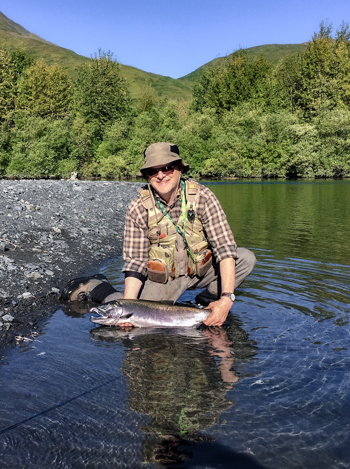 To bring them in from a distance, its best to have a flasher in front of your spoon. If you encounter a school or find a ball of bait fish on your fishfinder, you can mooch for them by jigging “crippled herring” or white, green, or blue jigs. When coho salmon are on the “bite” in the ocean, they can be pretty undiscriminating, so try something fun like surface poppers with a fly rod or create your own spoon. Can you catch one with a bare hook?
To bring them in from a distance, its best to have a flasher in front of your spoon. If you encounter a school or find a ball of bait fish on your fishfinder, you can mooch for them by jigging “crippled herring” or white, green, or blue jigs. When coho salmon are on the “bite” in the ocean, they can be pretty undiscriminating, so try something fun like surface poppers with a fly rod or create your own spoon. Can you catch one with a bare hook?
For freshwater fishing for coho salmon, conditions are everything. Fishing a given spot is going to be most heavily influenced by the conditions at the time for that stream, river, lake far more than the tackle you bring. Coho salmon like to rest where the water is slow, cool, and shaded when its available. In direct sunlight, warm temperatures, or with fishing pressure, they are often stressed and can be famously frustrating. If fishing a river or stream, look for slow moving water at the end of a riffle or a side channel or slough that offers a resting area, areas with cover such as overhanging trees or shade offered by a cut bank are favorite spots as well. If fishing a pond or lake, aim to fish early in the morning or on a cloudy day as they are likely to be more active and aggressive when it’s cooler. If you’re looking for good coho fishing weather, think duck-hunting weather: rain, wind, and clouds often make for the best fishing! For tackle, if the conditions are right, such as after a heavy rain or flooding event, it probably won’t matter much 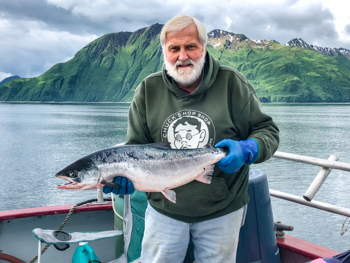 what you throw at them as long as the fish can see it. Favorites are Vibrax spinners and Pixies with pink and green being the most popular. For flies, it never hurts to go big and ugly. Bright, hairy articulated leeches, flashy streamers, and heavy, bright flies like Zonkers are often the ticket for coho salmon the fly. There are times, though, that coho’s will frustrate even the best anglers and it is always good to have a quiver of options available. If you’re fishing mid-day, or on pressured fish, or if the water is warm and low, coho are notorious for having jaws locked tight and will snub their favorite spinners and flies that worked even just that morning. Here is where it’s good to not be set on one style of fishing. For spin fishing, try using the slowest retrieve possible and the largest, brightest spinner you have. Spinners with large blades can usually be retrieved slower than smaller spinners. A number 5 chartreuse Vibrax is obnoxious and unwieldy in a lot of places, but for lock-jawed coho it can often entice a fish or two to open up with the right presentation. When fishing slow or stagnate water, or if spinners just aren’t working, swapping over to a fly rod with purple or bright green leech can sometimes catch their eye. Again, presentation is the key; use a slow retrieve or even a jigging motion, giving them lots of time to react. Bait is often the go-to for the coho harvesters among us and can also be a tool to keep in your back pocket on the slow days. Cured salmon roe and even small chunks of herring beneath a bobber or just drifting along the bottom are often hard to resist for cohos and can tempt them to bite even on the slowest days.
what you throw at them as long as the fish can see it. Favorites are Vibrax spinners and Pixies with pink and green being the most popular. For flies, it never hurts to go big and ugly. Bright, hairy articulated leeches, flashy streamers, and heavy, bright flies like Zonkers are often the ticket for coho salmon the fly. There are times, though, that coho’s will frustrate even the best anglers and it is always good to have a quiver of options available. If you’re fishing mid-day, or on pressured fish, or if the water is warm and low, coho are notorious for having jaws locked tight and will snub their favorite spinners and flies that worked even just that morning. Here is where it’s good to not be set on one style of fishing. For spin fishing, try using the slowest retrieve possible and the largest, brightest spinner you have. Spinners with large blades can usually be retrieved slower than smaller spinners. A number 5 chartreuse Vibrax is obnoxious and unwieldy in a lot of places, but for lock-jawed coho it can often entice a fish or two to open up with the right presentation. When fishing slow or stagnate water, or if spinners just aren’t working, swapping over to a fly rod with purple or bright green leech can sometimes catch their eye. Again, presentation is the key; use a slow retrieve or even a jigging motion, giving them lots of time to react. Bait is often the go-to for the coho harvesters among us and can also be a tool to keep in your back pocket on the slow days. Cured salmon roe and even small chunks of herring beneath a bobber or just drifting along the bottom are often hard to resist for cohos and can tempt them to bite even on the slowest days.
Coho fishing season is a favorite time of year for many anglers, with good cause. These voracious fish are among the best fighting fish out there and are delicious on the BBQ or in the smoker. Get your gear ready and prepare for an arm workout!
Fish on!
Targeting coho salmon using a slip-bobber set-up
A slip-bobber set-up is a very effective way to target coho salmon in flowing water. Bait, such as cured salmon roe, or jigs can be floated under the bobber set-up. Be sure to check the regulations for the area you plan to fish before heading out.
This video demonstrates how to target coho salmon using a slip-bobber set-up at a fishery in Anchorage. This method can be used anywhere to target coho in flowing water.
A fishing story about a Kodiak kid
By Bo Whiteside
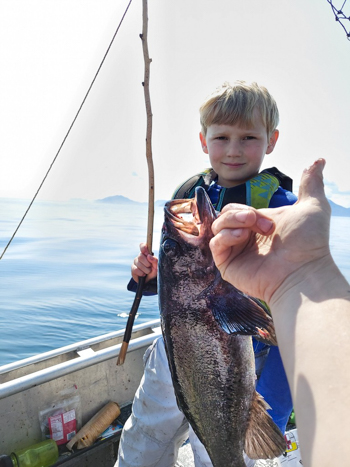 This fishing story took place on Kodiak Island on July 15, 2021. It was a beautiful summer day. The sun was shining bright, and the water was glass calm. I was onboard a friend’s skiff, and we were heading out for a day of trolling and jigging for whatever was willing to bite that day. The skipper was Chris Sibrel, and his sons Lachlan (6 years old) and Landon (10 years old) were with us as well.
This fishing story took place on Kodiak Island on July 15, 2021. It was a beautiful summer day. The sun was shining bright, and the water was glass calm. I was onboard a friend’s skiff, and we were heading out for a day of trolling and jigging for whatever was willing to bite that day. The skipper was Chris Sibrel, and his sons Lachlan (6 years old) and Landon (10 years old) were with us as well.
During the steam out to the fishing grounds, I noticed Landon was whittling on an alder branch with a pocketknife. I asked him what he was working on, and he replied, “I’m making a fishing pole”. I said that was awesome and provided some encouragement. He went back to his whittling and then shifted his attention to gathering materials laying around the boat to continue his crafting. He politely asked his dad if he could use a piece of twine that was laying around, which was met with a yes. He attached the twine to the alder branch and secured it with a bit of electrical tape. Landon continued his search for materials and found a tangled-up piece of monofilament line, a couple of rusty old hooks, and a sinker. He spent a considerable amount of time untangling the mono, attaching it to his twine, tying the hooks on, and attaching his sinker, which resulted in quite an impressive rig!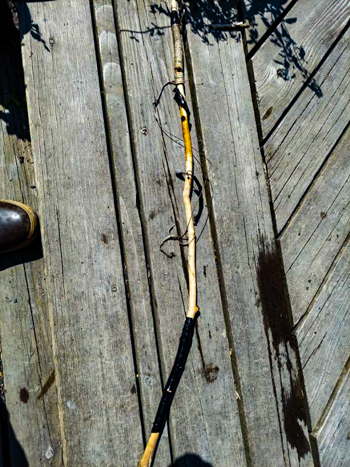
We arrived on the fishing grounds and trolled for a bit, then decided to shift to jigging for halibut and rockfish. We passed rods around and starting jigging. When asked if Landon would like a rockfish jigging rod, he stated he would like to use his custom rod. I kept an eye on his next steps. He searched the boat for some bait and found some smashed up pieces of herring on the deck. He proceeded to bait his hooks with this mushed-up herring and tossed it over the rail. What happened next was simply incredible. He hooked up! His little alder branch was bent over and the fight was on! Without aid, Landon hauled in a beautiful black rockfish. I was in awe and we all congratulated him on his impressive catch. Well, Landon was just warming up. He rebaited his custom fishing rig with more smashed bits of herring he found on the deck and tossed his line in the water. Fish on! This time his little alder branch was almost doubled over and I wasn’t sure what he had on there, but I knew he had a fight on his hands. I leaned over the rail to see that he had doubled up!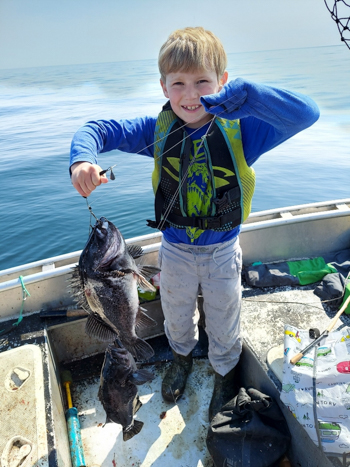 There were two really nice rockfish on his line. Landon was as cool as a cucumber as he battled the fish on the other end of his rod, eventually hand lining them over the rail and into the boat. The boat exploded with cheers! I couldn’t believe what I had just witnessed. He managed to hook and land a double on his custom fishing rig. Wow!!!
There were two really nice rockfish on his line. Landon was as cool as a cucumber as he battled the fish on the other end of his rod, eventually hand lining them over the rail and into the boat. The boat exploded with cheers! I couldn’t believe what I had just witnessed. He managed to hook and land a double on his custom fishing rig. Wow!!!
I think most of us at some point during our childhood have created our own custom fishing rods using sticks, twine, and tangled up fishing line sitting around. I know I never had much luck on mine, and I can’t say I’ve seen any others do much better. To watch this brilliant Kodiak kid create this rig and catch those rockfish is a memory I will never forget, and I can’t stop smiling as I write this. Great job Landon! We’re all very proud of your accomplishment!
An excellent remote float in Western Alaska: the Kisaralik River
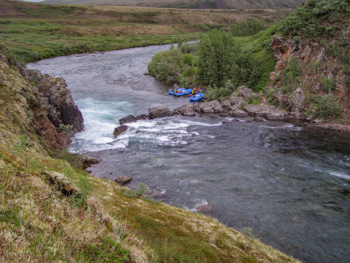 The Kisaralik River is an exciting whitewater float for intermediate boaters, combined with excellent fishing. The river is swift, with long stretches of small rocky rapids. The upper half of the river flows through a moderate-sized, tundra-covered valley enclosed by the mountains rising 2,000-3,000 feet above the floor. Low ridges parallel the river for short distances creating low bluffs. The lower Kisaralik traverses the Kuskokwim lowlands, where the river transitions to a very slow, meandering course. A riparian forest of paper birch, aspen, and spruce surrounds part of this lower reach.
The Kisaralik River is an exciting whitewater float for intermediate boaters, combined with excellent fishing. The river is swift, with long stretches of small rocky rapids. The upper half of the river flows through a moderate-sized, tundra-covered valley enclosed by the mountains rising 2,000-3,000 feet above the floor. Low ridges parallel the river for short distances creating low bluffs. The lower Kisaralik traverses the Kuskokwim lowlands, where the river transitions to a very slow, meandering course. A riparian forest of paper birch, aspen, and spruce surrounds part of this lower reach.
There is good mountain scenery and good hiking throughout the upper half of the river. Seasonally good fishing for king and silver salmon, as well as Arctic grayling, Dolly Varden, and rainbow trout. Chum salmon and sockeye salmon are also present, as well as the occasional pink salmon. Most species are attracted to egg patterns, especially during salmon spawning. Sockeye may be caught in locations where they are abundant, but they don’t tend to be an aggressive feeder. Silver and flashy streamers may work well below water, and dry flies are popular during the right conditions. Topwater patterns such as mouse patterns or other topwater patterns can be very effective for rainbow trout. Spoons, spinners and jigs of your choice work well for spinning gear, with many anglers choosing flesh colored gear, or white, pink and silver.
Watercraft: Recommend raft or kayak. Canoes suitable for experienced paddlers.
Time: 6 days from Kisaralik Lake to the mouth.
Special considerations: There are four, short (50 yards or less) Class III rapids and one 20 yard long class VI waterfall. The latter can easily be portaged on the left side of the river. Heavy rain can bring high water quickly, forcing new channels and decreasing fishing ability due to turbid, turbulent water.
The ridge through which the river cuts to form the Class VI falls and Quicksilver Creek (1 1/2 miles upstream) are recognizable landmarks.
Access: IN - Floatplane from Bethel to Kisaralik Lake. OUT: The lower several miles of the Kisaralik are suitable for floatplane take-out. As a variation, it is possible to arrange for a riverboat pick-up (inquire locally).
Regulations:
- Open to fishing year-round.
- Rainbow trout limits: In all flowing waters upstream of the Akiak Village Lodge site (60° 49.5’ N, 160° 55.0’ W), rainbow trout retention prohibited. All rainbow trout must be released immediately.
- In all flowing waters downstream of the Akiak Village Lodge site (60° 49.5’ N, 160° 55.0’ W), 2 per day, 2 in possession, only one of which may be 20 inches or longer. • There is an annual limit of 2 rainbow trout 20 inches or longer. Immediately upon landing and retaining a rainbow trout 20 inches or longer, you must fill out a harvest record; see page 5.
- In flowing waters upstream of the Akiak Village Lodge site (60° 49.5’ N, 160° 55.0’ W): • Only 1 unbaited, single hook, artificial lure or fly may be used year-round.
USGS Maps (1:250,000): Bethel
Public land Manager: State {upper 15 miles) and BLM.
Send us your best shot!
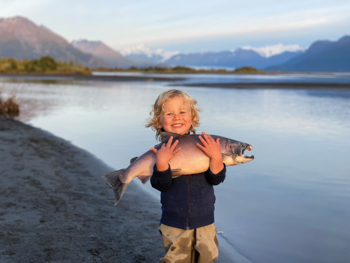 Did you take any good pictures this year of fishing with friends or family? If so, consider submitting a few shots to the 2022 sport fishing regulation summary cover photo contest.
Did you take any good pictures this year of fishing with friends or family? If so, consider submitting a few shots to the 2022 sport fishing regulation summary cover photo contest.
Every year the Alaska Department of Fish and Game (ADF&G), Division of Sport Fish, publishes four regional Sport Fishing Regulation Summary booklets - Northern, Southcentral, Southeast, and Southwest.
ADF&G is now accepting photo entries of youth anglers and families or friends fishing together for the cover photo contest. We also encourage anglers to submit images showing the diversity among those who fish in Alaska. The submission deadline for photo entries with a completed and signed Media Consent Release Form is 5:00 p.m. Saturday, October 31, 2021.
A maximum of three photos may be entered. Lay-out restrictions are such that only horizontal photos will be considered for the front cover. Both vertical and horizontal photos will be considered for inside pages which have no age requirement. For photo submissions to be considered, all photos accompanied by a completed Media Consent Release Form with the youth anglers’ parent or guardian must sign. Please include the name of the body of water or drainage in which the photo was taken and information about the angler(s) in the photo. Photos that show evidence of fish and game violations, unethical, or unsafe actions or advertisement will not be considered – this includes youths in a boat without a life vest.
Please email all photos and a completed and signed Media Consent Release Form to the appropriate region where the fish was caught to the following individuals:
- Northern Alaska: Erik Anderson in Fairbanks, erik.anderson@alaska.gov
- Southcentral and Southwest Alaska: Kali Hulquist in Anchorage, kali.hulquist@alaska.gov
- Southeast Alaska: Coral Bauer in Juneau/Douglas, coral.bauer@alaska.gov
For more information on the contest, please visit this webpage.
Do you know your rockfish?
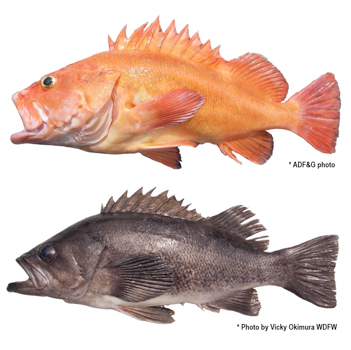 Over 40 species of rockfish inhabit Alaska salt waters. In 2017, the Alaska Department of Fish and Game began a statewide effort to develop management strategies for black and yelloweye rockfish in the Gulf of Alaska. The Statewide Rockfish Initiative (SRI) is made up of staff from both commercial and sport fish divisions, and from regions across the Gulf.
Over 40 species of rockfish inhabit Alaska salt waters. In 2017, the Alaska Department of Fish and Game began a statewide effort to develop management strategies for black and yelloweye rockfish in the Gulf of Alaska. The Statewide Rockfish Initiative (SRI) is made up of staff from both commercial and sport fish divisions, and from regions across the Gulf.
You can learn more about the SRI and check out some recently updated content on our website (including a rockfish identification page).
Field to Plate - Recipe of the month
Recipe of the Month – Salt and Pepper Whole Alaska Rockfish with Olives and Capers
 Try this delicious recipe for salt and pepper whole Alaska rockfish with olives and capers from the Alaska Seafood Marketing Institute.
Try this delicious recipe for salt and pepper whole Alaska rockfish with olives and capers from the Alaska Seafood Marketing Institute.
Enjoy!
If you have any questions about the Reel Times newsletter, please contact Ryan Ragan at ryan.ragan@alaska.gov
